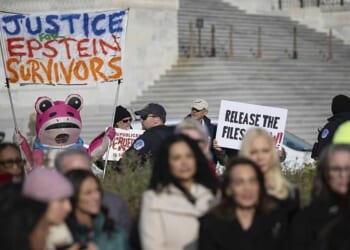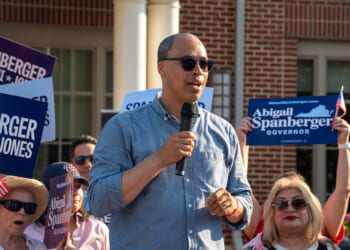The themes of rebirth, renewal, and restoration are intimately familiar and indeed deeply tied to the human experience. Ancient mythologies spoke of the phoenix, a bird that died in a flash of fire but was reborn from its ashes. The theme of rebirth is repeatedly present in the Bible. In the Old Testament, renewal is integral to the story of Noah and the flood, the deliverance of the Israelites from slavery in Egypt, and the promise of the Messiah to Abraham and his descendants. In the New Testament, Jesus repeatedly returns to the theme of rebirth and renewal, including with his own crucifixion and resurrection.
But there are also stories of national and cultural renewal. The fall of the Roman Empire in the fifth century presaged the period we call the “Dark Ages,” which eventually led to the rise of Christian Europe in the Middle Ages and to the Renaissance, a period that once again drew upon themes of rebirth and when great scientific, artistic, and cultural achievements were made and old ones revived.
In the United States, the theme of rebirth is hardly a foreign one. The nation was founded with a revolution that brought a new people and way of life, radically different from any that existed at that time. Less than a century later, President Abraham Lincoln spoke of a “new birth of freedom” as the nation was plagued by the bloody and divisive Civil War.
In his reelection campaign in 1984, President Ronald Reagan declared that “it’s morning again in America,” with a clear message that the economic and cultural revival the nation was experiencing was due to his policies. There’s a reason that these themes of revival, renewal, or restoration resonate. People generally seek reasons to be optimistic because it makes them happy. In times of difficulty or hardship, a promise of change, one that brings with it a revival of happier times since gone, is a powerful and uplifting message.

In October 2021, the Washington Examiner began Restoring America, a campaign founded on a “stark” diagnosis of the state of the nation. “America is going wrong,” we wrote. “Many people know it to be true; they can feel our politics and culture turning ever more sour, taste the bitter reality of national decline.”
The nation was barely a year into the shameful disaster of the Biden administration. The COVID-19 pandemic was well into its second year, along with the draconian policies curtailing individual freedoms that accompanied it. The nation was still dealing with the aftermath of the summer 2020 Black Lives Matter riots and an especially fraught presidential election. State-sponsored censorship was eroding the fundamental right to freedom of speech. The nation’s standing in the world was quickly diminishing, culminating in the disastrous and tragic withdrawal from Afghanistan and the Russian invasion of Ukraine. Skyrocketing inflation forced many people to make difficult sacrifices just to get by.
For many people, it felt as though America’s best days were behind it and the nation had entered an era of irreversible decline. Six months later, in July 2022, according to the RealClearPolitics average, the belief that the nation was on the wrong track reached 74% of people, while those who believed the nation was on the right track bottomed out at 18%.
This was the backdrop against which the Washington Examiner launched the Restoring America campaign. At a time when decline felt inevitable and a depressed malaise was setting in, our project was explicitly aimed at building toward a national renewal, or rather, a restoration, that would reverse this feeling of decline and give people reason to hope and feel optimistic about their nation once more.
To accomplish this goal, Restoring America was grounded in the belief that the seeds for national revival were planted within the nation’s founding documents and philosophy. As editor-in-chief Hugo Gurdon wrote, a “campaign that respects what our founders bequeathed us seeks what is necessary for America to thrive for generations to come. The fact that our founding values enabled America to achieve stunning success for more than two centuries is a testament to their efficacy and universality. They worked. That is perhaps the strongest argument for defending them and handing them unharmed to our children and to American children yet unborn.”

The idea of a national renewal proliferated far beyond the Restoring America project. The powerful promise of renewal or restoration became the rallying cry of those who opposed the Left’s assault on the nation’s principles. Russell Vought, now the director of the Office of Management and Budget, spent his time out of government leading a think tank, the Center for Renewing America. As President Donald Trump promised to “Make America Great Again” on the campaign trail, he proclaimed the start of a new American “golden age” in his second inaugural address.
The 19th-century German statesman Otto von Bismarck is credited with coining the phrase “politics is the art of the possible, the attainable — the art of the next best.” America’s founders also understood that consensus and coalitions are necessary to accomplish anything in a republican system and maintain its legitimacy.
Much has changed in the four years since the launch of Restoring America. Joe Biden is no longer president, replaced by the man who preceded him. The cultural forces of the Left are in retreat, falling victim to their own overconfidence and excess. In the meantime, feelings of a possible cultural and societal renewal have crept into the national consciousness as the Left embraces a more desperate and, at times, violent posture. The Overton Window on cultural and political issues, once seemingly in a permanent shift to the Left, has suddenly swung abruptly and significantly to the Right. To put it another way, “the art of the possible” has significantly changed.
What has that looked like? Open displays of patriotism and national identity are encouraged and embraced to a degree hardly seen four years ago. Interest in religion and faith has begun to increase after decades of decline. Poisonous ideas that reject that historic American virtue of equality have lost traction. A renewed sense of subsidiarity, in which decisions are best made at the most local level, has emerged in the political conscience.
But despite the shift, there is a long way to go, and the goal of restoring America to a place that is loved by its people, admired and respected by those abroad, and feared by its enemies remains a goal that must be attained. At the same time, new challenges have emerged that threaten to curtail or even reverse the progress that has been made if it is not vigilantly defended.

The shocking and horrific assassination of conservative activist Charlie Kirk, who himself preached American revival through his organization Turning Point USA, was a reminder of the fragility of the cultural moment. As the Left has been forced into retreat, its fringes have become more volatile and dangerous, driven to a sense of desperation amid the nation’s emphatic rejection of its cultural and political project.
But that fragility is also at play, in a far less extreme way, in the general trends that the nation is experiencing. The cyclical nature of elections and the constant changes in our own lives remind us that what is true today may not be true tomorrow, and what may be culturally and politically ascendant today may be a cultural and political pariah tomorrow.
When the Washington Examiner launched Restoring America, we said this project would be sustained. We have spent the last four years publishing a wide range of commentary, news reporting, and video content that has sought to apply, in policy and culture, the six principles we believe form the foundation of what made America great in the first place and which form the necessary roots of its revival.
But four years into this project, it is time for an update. We are not rewriting the principles — rather, in the midst of these feelings of national revival, we are examining what has happened in the intervening years since the project was launched. First, we are identifying where progress has been made to recapture the spirit of those values in culture and policy, but also where progress has proved elusive. Second, we are identifying new challenges that have arisen over the past four years.
Patriotism and Unity
Four years ago, we declared that we would “campaign for children to be taught to love and respect America.” At the time, the Left’s radical cultural revolution was in full swing. Schools had become battlegrounds in the culture war as children in the youngest of grades were sorted into “affinity groups” based on their skin color and fed a narrative of oppression and victimization designed to divide them. Critical race theory, with its narrative that America is a fundamentally racist nation, had infiltrated school districts in the reddest counties in the reddest states and blue cities in blue states alike.
Today, critical race theory is in retreat. Political leaders in more than a dozen states mustered the courage to enact legislation definitively declaring that public education, funded by taxpayers, would not teach children to hate their nation or resent their neighbor. They did this without whitewashing or ignoring the reality of slavery and racism. Meanwhile, calls for slavery reparations, once gaining steam and advancing in states run by Democrats, have receded before a wave of public opposition. The calumnious charge of “racism,” although still hurled at political rivals without scruple, has lost its defamatory bite.

Perhaps no issue has seen such an enormous change as border security and immigration. In 2021, we said “patriotism and unity require that we actually have a country,” which meant having a recognizable and enforced border and a coherent and democratically responsive immigration system. Because of the Biden administration’s reckless open border policies, America took in more legal and illegal immigrants than it could manage. The border turned into the site of a humanitarian crisis, and cities and towns were stretched beyond their limits as they were inundated with foreigners who filled hotel rooms, closed schools, and overwhelmed public services.
With the return of Trump, that has changed. The once-chaotic border is now quiet, with no trace of the hordes that once overwhelmed it. Deportations have ramped up, and for the first time in decades, the foreign-born population as a percentage of the national population is poised to decline.
But some goals have proven elusive. We noted in 2021 that a Gallup poll found U.S. national pride to be at an all-time low. This trend has proved stubbornly resistant, even in the face of the sentiments of renewal. This year, Gallup found that national pride has fallen even lower than previous records. National unity has never felt further away, as polarization and political divisions have persisted. Students today are doing no better in school than they were before, as reading, writing, and math scores have all seen steep and persistent declines, raising troubling questions about the capabilities of America’s future leaders, even as divisive topics such as critical race theory have been pushed out of the classroom.
Faith, Freedom, and Self-Reliance
While attacks on the mainline Christian faith have not ceased from those who seek to upend and repudiate the nation’s cultural heritage, faith has begun to return. According to a recent Pew Research study, the share of the population that identifies as Christian has halted a decadeslong decline. In 2025, 63% of the population identified as Christian, the same as in 2019, and higher than the 60% of 2022.
This is welcome. The restoration of America cannot take place without a religious revival. Study after study has shown that religious practice is associated with higher degrees of personal responsibility, social and familial stability, and general happiness. A revival of faith brings a revival of family, community, and individual success.
But there cannot be individual success without individual responsibility. While the One Big Beautiful Bill Act took meaningful steps toward encouraging individual responsibility, a culture of victimhood and slothful and solitary nihilism has spread among young people. Addictions to pornography and gambling are widespread, enslaving users who, in turn, seek to blame anyone other than themselves for their predicaments, even as these vices inflict lasting societal harms.

But the winds of freedom have strengthened. Tech companies that used their monopolistic power to suppress and censor dissenting viewpoints have retreated and found reason instead to champion freedom of expression, even if their motives are likely commercial rather than principled. Elon Musk’s purchase of Twitter, now X, was a landmark moment for freedom of speech and proved to be the first act of a new cultural commitment to free speech that eventually brought most of Silicon Valley with it.
But challenges remain. Red tape stifles economic growth, which, in turn, discourages new business owners and leads to higher costs. Shortages in the housing supply have increasingly made property ownership a luxury only those in the upper classes can afford. A sense of economic desperation among those whose economic outlook a generation ago would have easily been considered middle class has doubtless contributed to the growing and insidious appeal of socialism, which promises to make right what, in many cases, the government itself made wrong.
Courage, Strength, and Optimism
In many ways, the world is more fraught and dangerous than it was four years ago and in need of American leadership more than ever. After four years of Biden, Russia and China have been emboldened, and Iran has only recently been checked by the U.S. and Israel after being allowed to believe it could defy America with impunity and unleashing its proxies in barbaric attacks on civilization. Multilateral organizations have proven to be feckless, confident in condemning those who oppose bad actors.
But some things have improved. Trump’s return to the White House has heralded a new era of forceful American diplomacy that is seeing strong actions, at least in some areas, rewarded. Policy toward Russia is still appeasing, but countries that make up the North Atlantic Treaty Organization are taking seriously their commitments to spend at least 3% of GDP on defense.
At home, this has led to the first trillion-dollar Pentagon budget, a welcome step toward restoring U.S. defense spending at a time when China is building its military might and preparing to invade Taiwan. The U.S. military is stronger today than it was even a year ago because of the resurgence of morale that has turned a woeful recruiting crisis into a recruiting surplus. There is a concerted effort to rid the military of social experimentation and focus on winning or deterring wars.
In 2025, the Army surpassed its recruiting goal by 10%, one year after barely meeting it and after several years of missed goals. The Navy missed its recruitment goal in 2023 but exceeded it by 4,000 two years later, and the Air Force exceeded its 2024 goal, a year after missing it.
This renaissance of American military might is the direct result of policy decisions that restored the image of the military as a fighting force for good that wins wars and deters bad actors, not a laboratory for social and cultural experimentation that enforces a divisive worldview among its members. This is hard-fought and fragile progress that can be lost by the whims of policymakers. Those who would lead our soldiers would do well to remember that a weak fighting force makes for a weak nation.
Much work remains. China is still in a prime position to fill any leadership vacuum that the U.S. leaves, and Russia remains undeterred in its war against Ukraine. The U.S. is grappling with soaring debt that threatens our financial stability and thus our ability to project strength to the rest of the world. A return to fiscal sanity is still needed to make America’s economic influence abroad stronger.
Equality, Not Elitism
Among the most welcome developments of the past four years has been the utter discrediting of many elite institutions and their gatekeepers. Lest we forget, 2021 was a time of school closures and imposed medical mandates. Those who dissented were punished.
It was a time when the words of George Orwell resonated strongly: “One has to belong to the intelligentsia to believe things like that: no ordinary man could be such a fool.” There has been a genuine awakening to the fact that having a credential or occupying a place of authority does not alone make one an expert, and to be a true expert requires the humility to admit when one is wrong. One of the hallmarks of America has been the trust that we put in our citizenry to make choices about their own lives and recognize that those decisions vary from person to person.
The 2024 election was a rejection of the elite snobbery directed toward those outside the upper political caste. This has had enormous ramifications. Hollywood, the playground of the Left, where creativity had reached an agenda-driven dead end, has suddenly begun to wonder if ignoring the interests and values of half or more of the nation was good for business, and if the social engineering it championed was worth the lost audience and lost business.
This rejection of elitism is a revival of equality. The federal government has stopped ceding control of policymaking to unelected bureaucrats and “experts” and is seeking to restore democratic accountability to institutions.
But respect for human life is still lacking. More Americans than ever support abortion without restrictions, even as the Supreme Court ended the legal catastrophe of Roe v. Wade three years ago and returned the question of abortion policymaking to the people. But even here, this mishmash of laws has restored the fundamental premise that the people do not need judges to decide policy — many states declared protection for the unborn an essential aspect of an equal society.
Community and Family
If there is one place that the American revival has yet to bring significant change, it is in the strengthening of families. Four years ago, we said, “The American family has never been weaker.” It is arguably even weaker today. The Centers for Disease Control and Prevention recently revealed that the fertility rate reached an all-time low. Americans are now less likely to be married than at any other time in history. We are a nation that currently refuses to replace itself. Until we restore the family as the foundational building block of our society, any immediate-term sense of revival will be short-lived and misplaced.
New threats to family and community are emerging. While the advent of artificial intelligence brings promise of new technological advancement, we cannot be indifferent to its dangers. Companionship and friendship cannot be found with a computer program, only with members of our community.
The architects of technological advancement, especially in Silicon Valley, seem to espouse an ideology that human perfection and success can be found in technology. A virtual utopia that promises pleasure is one that strips humanity of its purpose and will lead to more isolation and misery. This transhumanist cancer must be rejected in favor of a perspective that sees technological advancement as the servant of humanity, and not the other way around.
Our homes and our towns are where the revival of America must occur because they are the only places where we can find comfort and meaning. Our governments must work to revive community. That means removing regulatory barriers that have created cultural, social, and economic factors that discourage family formation. It also means that the federal government must do much more to allow states to govern themselves.
Fairness and Justice
Among the most welcome developments over the past several years has been the emergence of a national consensus that law enforcement needs the support and space to uphold and enforce the law.
Four years ago, the Left was pushing to defund the police and refusing to prosecute serious crimes. While America is still suffering from the effects of this, the revolutionaries who sought to empower criminals and cripple police have retreated. Cuts have been reversed to police budgets, which, in many cases, have increased, and radical district attorneys who refused to prosecute crimes have been ousted by voters in several instances. But violence and danger persist. The assassination of Kirk is a reminder that there are still those who use violence as a tool of influence and fear.
Elsewhere, the Left’s hold on the dishonest and biased coverage of legacy media institutions has begun to soften somewhat, even though examples of the “dishonest and hypocritical news coverage” we pledged to call out four years ago still abound. Election security and fairness are still a struggle, as many states refuse to count votes in a timely fashion and continue to reject voter identification.
Conclusion
The project to restore America is ongoing, but we are pleased to say that it has taken its first steps. When we launched this project, we said the nation “has become almost unrecognizable to many of its own citizens.” Today, the tide has turned. Cultural and political revival means more people feel the country is on the right track than did so four years ago. That is worth celebrating. But to ensure that the American renaissance lasts will require continued fortitude, courage, and resolution from a nation that has already shown itself to be among the most resilient in human history.
Jeremiah Poff is the Restoring America editor for the Washington Examiner.

















